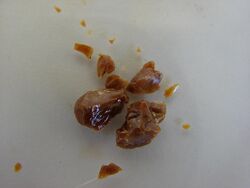Tolu balsam
Topic: Chemistry
 From HandWiki - Reading time: 2 min
From HandWiki - Reading time: 2 min
Tolu balsam[1] or balsam of Tolu[2] is a balsam that originates from South America (Colombia, Peru, Venezuela). It is similar to (and frequently confounded with) the balsam of Peru.
It is tapped from the living trunks of Myroxylon balsamum var. balsamum.[1] The fresh balsam of Tolu is a brownish, sticky, semifluid mass. It gradually becomes a brittle solid, but softens again when it is warm.[2] The balsam contains a fairly large amount of benzyl and cinnamyl esters of benzoic and cinnamic acid (benzyl benzoate, benzyl cinnamate).[3]
Collection
Balsam of Tolu is obtained by cutting a V-shaped wound on the trunk of Myroxylon balsamum var. balsamum and fixing a calabash there to catch the exuded resin.[2]
Uses
The resin is still used in certain cough syrup formulas. However its main use in the modern era is in perfumery, where it is valued for its warm, mellow yet somewhat spicy scent.
It is also used as a natural remedy for skin rashes. It is a well known cause of contact dermatitis, a form of skin allergy.
Tolu has begun to be used in the niche perfume industry, notably by Ormonde Jayne Perfumery, which launched its oriental perfume Tolu in 2002, and also in 2010 by Esteban, which launched Baume Tolu.
History
In 1841, Henri Étienne Sainte-Claire Deville isolated toluene by the dry distillation of tolu balsam.[4] The resin is used in traditional medicine by the people of Central America and South America.[5] It got its name because it was shipped to Europe from Tolú, Colombia.[2] In 1753 Linnaeus described the type specimen of Toluifera balsamum (the synonym of Myroxylon balsamum) using a specimen collected in the province of Cartagena, probably a town called Tolú, which at the time was located in the province of Cartagena, and named it Toluifera balsamum in relation to the place of collection.[6] The name of the important hydrocarbon solvent toluene is derived from Tolu balsam.
References
- ↑ 1.0 1.1 "Assessment report on Myroxylon balsamum (L.) Harms var. pereirae (Royle) Harms, balsamum". Committee on Herbal Medicinal Products (HMPC). 2016-05-31. https://www.ema.europa.eu/en/documents/herbal-report/final-assessment-report-myroxylon-balsamum-l-harms-var-pereirae-royle-harms-balsamum_en.pdf.
- ↑ 2.0 2.1 2.2 2.3 Flückiger, Friedrich August; Hanbury, Daniel (1874). Pharmacographia: A History of the Principal Drugs of Vegetable Origin, Met with in Great Britain and British India. London: Macmillan and Co.. pp. 177–184. https://www.biodiversitylibrary.org/item/179477#page/201/mode/1up.
- ↑ Karl-Georg Fahlbusch (2007), "Flavors and Fragrances", Ullmann's Encyclopedia of Industrial Chemistry (7th ed.), Wiley, p. 116
- ↑ Jörg Fabri (2007), "Toluene", Ullmann's Encyclopedia of Industrial Chemistry (7th ed.), Wiley, p. 4
- ↑ James A. Duke (2009), Duke's Handbook of Medicinal Plants of Latin America, CRC Press, pp. 474–475
- ↑ Bagnatori Sartori, Ângela Lúcia; Lewis, Gwilym P.; Mansano, Vidal de Freitas; Tozzi, Ana Maria Goulart de Azevedo (6 November 2015). "A revision of the genus Myroxylon (Leguminosae: Papilionoideae)". Kew Bulletin 70 (4): 48. doi:10.1007/s12225-015-9604-7.
 |
 KSF
KSF
